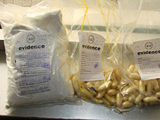Mexican Cartels’ Andean Stronghold
By Eliot Brockner for ISN
Oscar Nina, the commander of Bolivia’s Special Forces to Combat Drug Trafficking (FELCN), external pageadmittedcall_made on 28 October 2009 that Mexican drug trafficking organizations (DTOs) are financing and controlling the production of cocaine at labs throughout Bolivia via Colombian and Bolivian intermediaries.
Though Nina was quick to mention that the Mexican DTOs do not actually operate on Bolivian soil on a grand scale, but rather have influence through already established criminal organizations within Bolivia, which may even include external pageFARC rebels or other Colombian cartelscall_made with know-how and skills in production, his comments confirm a trend feared by many analysts: The reach of Mexican cartels, responsible for some of the worst violence in Mexico’s history, extends far beyond that country’s borders.
The revelation speaks to the ability of the DTOs to collaborate with local criminal organizations to aid in the production and transportation of illicit drugs. There is significant evidence, highlighted in a external pagereport published last monthcall_made by the United Nations Development Programme (UNDP), that Mexican cartels control shipping lanes throughout Central America, preying upon weakened states such as Honduras and Guatemala as gateways to ship illicit drugs by land, sea and air en route to the US as well as local markets.
But Nina’s admission proves that it is not merely shipping lanes that the DTOs are after.
The entire operation, from production to consumption, has the capacity to involve many countries. A hypothetical example: Coca leaves grown in Bolivia may be processed into paste, shipped over land and synthesized and packaged into market-ready cocaine at a lab in Colombia, loaded onto a private aircraft registered in Venezuela that lands in Honduras, then shipped over land through Guatemala and Mexico before reaching the US.
At each step of the way, local intermediaries need to be there to facilitate the process. But at the top of the ladder controlling the entire process are the omnipotent Mexican cartels. This scenario does not even account for the other big emerging market: cocaine synthesized at labs in Bolivia en route to Europe by way of Brazil and West and North Africa.
Controlling production is thus vital to the operation, and Bolivia’s production capacity and coca culture makes the country a particularly attractive choice for Mexican DTOs looking to control production.
Bolivian President Evo Morales, a former coca farmer, has been sympathetic to the growing of the leaf. But in 2008, of the 54,000 tons of coca leaves grown in Bolivia, external pageonly 21,778 (40 percent) were sold legallycall_made. In an August 2009 article, the Wall Street Journal quoted an analyst who suggested that Bolivia, the world’s third largest coca producer, was "external pagethe path of least resistancecall_made" for Mexican cartels looking to control production.
The international nature of the trade calls for multilateral cooperation. FELCN, in spite of receiving intelligence from external pagePerucall_made and other sources, cannot go it alone. FELCN has external pageopenly declaredcall_made that the US Drug Enforcement Administration (DEA) expulsion has negatively affected their operations and has already captured more cocaine in 2009 than in 2008. Whether that is the result of improved technologies or more coca to find because of increased production is unclear, though evidence points to the latter.
The expulsion of the DEA in November 2008 opened the door for the potential for broader international collaboration to combat drug smuggling. One year later, as external pageMorales expresses interestcall_made in improving ties between the US and Bolivia, this remains as necessary as ever.

